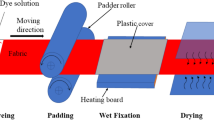Abstract
Colour fading is now a popular process used for imparting a vintage look to textile and fashion products, which enhances market value because of the current fashion trends. This study examined a non-aqueous colour fading process with the use of oxygen plasma-induced ozone treatment. An industrial scale machine and commercially available red sulpur-dyed cotton fabric (with 0.5 %, 1.5 % and 2.5 % colour depths) were used in this study. Since the colour fading process factors are inter-related to each other, a specific experiment approach, i.e. orthogonal method, was used for obtaining the optimum conditions in an industrial scale colour fading process. Three process factors used in the industrial scale colour fading process, i.e. (i) oxygen gas concentration (%); (ii) amount of water in fabric (%); and (iii) treatment time (minutes), would be studied in this paper. Through the orthogonal method, the optimum conditions for colour fading of the three colour depths of cotton fabric dyed by red sulphur dye were determined and their optimum conditions were same. The optimum conditions of the colour fading of the three colour depths were: (i) 70 % oxygen gas concentration; (ii) 35 % amount of water in fabric; and (iii) 30 minutes treatment time. Although colour fading conditions are the same, the order of importance of these process factors was different. Unlike the conventional colour fading process, oxygen plasma-induced ozone colour fading treatment can achieve uniform and even colour fading effect in the cotton fabric effectively.
Similar content being viewed by others
References
2012 LEVI STRAUSS & CO. Available on line: http://store.levi.com/waterless/index.html. Accessed 14 September 2018.
A. Card, M. A. Moore, and M. Ankeny, AATCC Rev., 5, 23 (2005).
M. Sariisik, AATCC Rev., 4, 24 (2004).
A. Cavaco-Paulo, Carbohydr. Polym., 37, 273 (1998).
N. Özdil, E. Özdogan, and T. Öktem, Fibres Text. East. Eur., 11, 58 (2003).
C. W. Kan, H. F. Cheung, and Q. Chan, J. Clean. Prod., 112, 3514 (2016).
C. W. Kan, C. F. Lam, C. K. Chan, and S. P. Ng, Carbohydr. Polym., 102, 167 (2014).
H. Chen, M. Guo, X. Yao, Z. Luo, K. Dong, Z. Lian, and W. Wei, Fiber. Polym., 19, 722 (2018).
T. Salem, F. Simon, A. Atef El-Sayed, and M. Salama, Fiber. Polym., 18, 731 (2017).
F. Emami, S. Shekarriz, Z. Shariatinia, and Z. Moridi Mahdieh, Fiber. Polym., 19, 1014 (2018).
R. Morent, N. De Geyter, J. Verschuren, K. De Clerck, P. Kiekens, and C. Leys, Surf. Coat. Technol., 202, 3427 (2008).
C. C. Wan, L. H. Lin, C. W. Chen, and Y. C. Lo, Polymers, 9, Article Number 371 (2017).
C. Chen, L. Jia, R. Liu, X. Chen, C. Jin, H. Liu, C. Feng, C. Zhang, and Y. Qiu, Fiber. Polym., 17, 1181 (2016).
J. B. Zhang, Z. Zheng, Y. N. Zhang, J. W. Feng, and J. H. Li, J. Hazard. Mater., 154, 506 (2008).
H. Khan, N. Ahmad, A. Yasar, and R. Shahid, Pol. J. Environ. Stud., 19, 83 (2010).
H. A. Eren and D. Ozturk, Text. Res. J., 81, 512 (2010).
H. H. Piccoli, A. U. U. de Souza, and S. M. A. G. U. de Souza, Ozone: Sci. Eng., 37, 170 (2015).
M. Ghoranneviss, B. Moazzenchi, S. Shahidi, A. Anvari, and A. Rashidi, Plasma Process Polym., 3, 316 (2006).
M. Ghoranneviss, S. Shahidi, B. Moazzenchi, A. Anvari, and A. Rashidi, Surf. Coat. Technol., 201, 4926 (2007).
C. W. Kan, H. F. Cheung, and F. M. Kooh, Fiber. Polym., 18, 767 (2017).
H. F. Cheung, Y. S. Lee, C. W. Kan, C. W. M. Yuen, and J. Yip, Appl. Mech. Mater., 387, 131 (2013).
G2 Technology. Available on line: https://www.jeanologia.com/portfolio/g2-prueba/ Accessed 14 September 2018.
C. E. Zhou, C. W. Kan, and C. W. M. Yuen, Cellulose, 22, 3465 (2015).
C. W. Kan, Fiber. Polym., 8, 629 (2007).
C. E. Zhou and C. W. Kan, Cellulose, 22, 879 (2015).
D. Zhong, Y. H. Liu, N. T. Cheung, C. W. Kan, and H. Chua, Processes, 6, Article Number 81 (2018).
C. L. Chong, S. Q. Li, and K. W. Yeung, J. Soc. Dyer. Colour., 108, 528 (1992).
Author information
Authors and Affiliations
Corresponding author
Rights and permissions
About this article
Cite this article
Liu, Yh., To, C.Km., Cheung, Hy. et al. An Orthogonal Study of Industrial Scale Colour Fading Process of Cotton Fabric. Fibers Polym 20, 588–594 (2019). https://doi.org/10.1007/s12221-019-1007-1
Received:
Revised:
Accepted:
Published:
Issue Date:
DOI: https://doi.org/10.1007/s12221-019-1007-1




